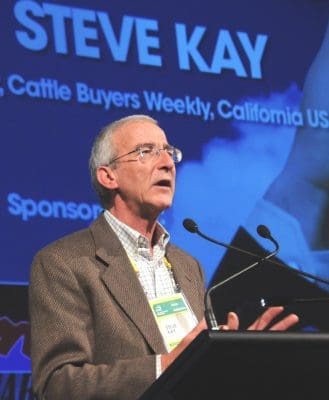
A monthly column written for Beef Central by US meat and livestock industry commentator, Steve Kay, publisher of US Cattle Buyers’ Weekly
CATTLE hides for the past few years have been waging a battle with synthetic materials that have increasingly been used in everything from footwear to car seats. New evidence suggests that synthetics have significantly impacted world-wide demand for leather. But the hides and leather industry, at least in the US, is fighting back.
The reason is obvious. Cattle hides for many years in the US added as much as US$60 to the value of a fed steer or heifer and accounted for two-thirds of the value of all by-products.
But as is also being seen in Australia, hide prices began eroding in 2018 and have not recovered. Now the COVID-19 pandemic has delayed any improvement in hide prices and the global leather market.
16pc of hides sent to landfill
Last year saw a highly depressed hide market. Nearly 16 percent of all US cattle hides produced went to landfill, because there was no market for them.
Global demand for hides and leather began to improve marginally at the start of this year ,but the onset of the pandemic heavily impacted demand as tanneries from China to Italy closed down.
This forced hide prices to go lower again and meant an even larger percentage of hides have gone into landfill than before the pandemic began. But tanneries, especially in China, appear to be operating more normally now and hide traders are cautiously optimistic that hide prices and global demand will start to improve again.
About 5.5 million US cattle hides failed to reach the leather value chain in 2019, says the Leather and Hide Council of America (LHCA). These hides have almost all gone into landfill, as there is no other practical way to dispose of them. A few more hides, percentage-wise, have gone into landfill since the onset of the pandemic, says LHCA president Stephen Sothmann.
Hide demand and prices saw the slightest bit of growth prior to COVID-19, says Sothmann. But they then weakened again. Native unbranded US hides in late August were fetching only US$29-30 versus a high of US$120 five years ago. Branded cow hides have no market so are all going into landfill. USDA at the end of August reported a butt-branded steer hide brought US$26.
Small price increase
China has been the major market this year for US hides, says Sothmann. Its tanneries and those in Italy are now up and running again. So the industry is finally seeing a very small price increase. Hopes are that prices will increase enough for hides to get back to breakeven levels in a couple of months, he says.

Declining new luxury vehicle sales is one of the factors behind slower demand for cattle hides for leather
Leather usage by auto-makers accounts for 20pc of global hide usage and has been the bright star for the leather industry. But 50-60pc of all leather goes into footwear and has been hard hit by the use of synthetic materials, he says.
The leather industry previously tried to compete with synthetic materials by making leather look just like synthetics, says Sothmann. The industry is now focusing on promoting the natural attributes of leather versus synthetic and is attempting to re-educate consumers about leather’s unique qualities, he says.
The industry was also feeling pretty good pre-pandemic that leather was becoming fashionable again among top clothing designers. The industry hopes this trend will grow, he says.
Meanwhile, following reports of hides and skins going to waste in Bangladesh after the recent Eid al-Adha festival, AJ Hollander’s chief operating officer, Ben Ganz, said in a post on social media that the same problem persists in the US.
AJ Hollander is based in New York and has hides processing plants in Nebraska, Texas, Tennessee and Wisconsin where it fleiches and cures hides and skins. It has a capacity to process 10,500 hides per day. It was no longer economically viable for AJ Hollander to collect and process certain hides, owing to their low value in the leather market, wrote Ganz. These hides are being dumped in landfills by packers instead.
The availability of cheaper, petrochemical-derived synthetic alternatives was one of the factors pushing the demand for and value of leather lower, wrote Ganz. US landfills are filling up and oil companies are profiting.
Clothing, furniture and auto manufacturers are happy too because they can use a cheaper oil-based product while claiming to be environmentally-conscious’. It is time for consumers to make it clear to finished product brands that they will not stand for these lies any more, he wrote.
Consumers who want to protect the environment should instead buy products made from leather produced in environmentally sustainable tanneries, Ganz wrote in his social media post.
Impact on by-product values
The low price of hides means that US by-product values are currently averaging only US$7-8 per cwt or US$98-112 per head. Contrast this with the record high prices in 2014. The weekly record of US$16.69 per cwt set the week ended August 23, 2014 put US$234 per head in US packers’ pockets. Those were the days when packers called by-product values (also called the drop credit) the ‘fifth quarter’ of an animal.
No one, however, will shed a tear for fed beef packers that hide prices and by-products values are the lowest in many years. US packers reported record beef earnings in the April-June quarter, with Tyson reporting operating income of US$615 million, which I calculate was close to US$500 per head. July and August saw margins of US$250-300 per head.
